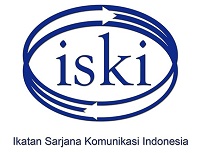Polymedia on Working Mothers with Long Distance Marriage
Abstract
People in this cyber era use various media to carry out all kinds of communication. the concept of polymedia sees how a person navigates and manages so many media according to their interpersonal communication needs. This study looks at the application of the polymedia concept to working mothers who experience Long Distance Marriage (LDM). The research method is descriptive qualitative with data collection techniques through interviews and observations. The informants in this study are working mothers who have a long-distance marriages. The results of this study in the polymedia contour section found that the informants develop the use of media by updating and combining several media. The most favorite or frequently used media are those with full features and low cost. The level of accessibility, affordability, and media literacy of informants varied but tended to move in a better direction. The results from the elements of polymedia are that the informants feel that the media can convey affection, feelings, and emotions in interpersonal communication with their families. In the element of remediation, there is a reciprocal relationship that informants choose the media that suits their interpersonal communication needs. Otherwise, technological advances in media have also changed how they communicate. Overall, Flexibility, focus, and adaptability are key for informants to navigate new media and their abundance of interpersonal communication.
Keywords
Full Text:
PDFReferences
Akbar, Z., & Kartika, K. (2016). Konflik Peran Ganda dan Keberfungsian Keluarga Pada Ibu yang Bekerja. JPPP - Jurnal Penelitian Dan Pengukuran Psikologi, 5(2), 63–69. https://doi.org/10.21009/JPPP.052.02
Baldassar, Loretta. (2016). De-demonizing distance in mobile family lives: co-presence, care circulation and polymedia as vibrant matter. Global NetworksVolume 16, Issue 2 / p. 145-163. First published: 08 February 2016 https://doi.org/10.1111/glob.12109
Baym, N. K., Zhang, Y. B., & Lin, M.-C. (2004). Social Interactions Across Media. New Media & Society, 6(3), 299–318. https://doi.org/10.1177/1461444804041438
Creswell, J. W., & Poth, C. N. (2016). Qualitative Inquiry and Research Design Choosing Among Five Approaches. SAGE Publishing.
Deuze, M., Blank, P., & Speers, L. (2012). A life lived in media. Digital Humanities Quarterly 6, 6(1). http://digitalhumanities.org/dhq/vol/6/1/000110/000110.html
DeVito, J. A. (2013). The Interpersonal Communication Book 13th Ed. Pearson Education Inc.
Ifadhah, N., & Irwansyah, I. (2022). Parenting Education and Persuasion of Gender Equality Within the Family on @Latihati. Mediator: Jurnal Komunikasi, 14(2), 240. https://doi.org/10.29313/mediator.v14i2.8124
Lestari, R. B. (2010). Pemberdayaan Wanita Melalui Teknologi Informasi (Sebuah Kajian Pustaka). Seminar Nasional Aplikasi Teknologi Informasi 2010 (SNATI 2010), 75–78.
MacKenzie, D., & Wajcman, J. (1999). Introductory essay. In: MacKenzie D and Wajcman J (eds) The Social Shaping of Technology, 2nd edn. Open University Press.
Madianou, M., & Miller, D. (2013). Polymedia: Towards A New Theory of Digital Media in Interpersonal Communication. International Journal of Cultural Studies, 16(2), 169–187. https://doi.org/10.1177/1367877912452486
Marettih, A. K. E. (2013). Work Family Konflik pada Ibu bekerja (Studi Fenomologi dalam Perspektif Gender dan Kesehatan Mental). Sosial Budaya, 10(1), 27–37.
Nadia, N., Janah, N., & Bustamam, N. (2017). Hubungan Resolusi Konflik Pasangan Suami Istri Bekerja dengan Kepuasan Pernikahan Pada Usia Pernikahan 3-5 Tahun. Jurnal Suloh, 2(2), 22–31. https://jurnal.unsyiah.ac.id/suloh/article/view/14101
Pei, X. (2021). Reshaping Co-Existence of Tradition and Modernity: Polymedia in Gender Identity Negotiation of Dagongmei. Journal of Ethnic and Migration Studies, 47(13), 3114–3130. https://doi.org/10.1080/1369183X.2019.1700788
Prameswara, A. D., & Sakti, H. (2016). Pernikahan Jarak Jauh (Studi Kualitatif Fenomenologis Pada Istri yang Menjalani Pernikahan Jarak Jauh). Jurnal Empati, 5(3), 417–423. https://ejournal3.undip.ac.id/index.php/empati/article/view/15360
Putri, D. W., Hamdan, S. R., & Yulianti, Y. (2017). Perilaku Bermedia Digital Dalam Pelaksanaan Tridharma Perguruan Tinggi Dikalangan Dosen Unisba. Mediator: Jurnal Komunikasi, 10(1), 11–24. https://doi.org/10.29313/mediator.v10i1.2731
Scott, A. T. (2002). Communication Characterizing Successful Long Distance Marriages [Louisiana State University and Agricultural and Mechanical College]. https://doi.org/10.31390/gradschool_dissertations.3840
Shoemaker, N. (2015, March). Social Media Plays a Big Role in Long-Distance Relationships. Big Think: Technology & Innovation. https://bigthink.com/technology-innovation/social-media-plays-a-big-role-in-long-distance-relationships/
Terry, A., & Gomez, R. (2011). Gender and Public Access Computing: An International Perspective. 2011 44th Hawaii International Conference on System Sciences, 1–11. https://doi.org/10.1109/HICSS.2011.211
Utami, K. P., & Wijaya, Y. D. (2018). Hubungan Dukungan Sosial Pasangan Dengan Konflik Pekerjaan-Keluarga Pada Ibu Bekerja. Jurnal Psikologi: Media Ilmiah Psikologi, 16(1), 1–8. https://ejurnal.esaunggul.ac.id/index.php/psiko/article/view/2351
Wajcman, J. (2002). Addressing Technological Change: The Challenge to Social Theory. Current Sociology, 50(3), 347–363. https://doi.org/10.1177/0011392102050003004
DOI: https://doi.org/10.29313/mediator.v15i2.10503
Refbacks
- There are currently no refbacks.

This work is licensed under a Creative Commons Attribution 4.0 International License























